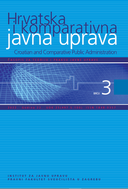E-Inclusion of Vulnerable Groups: Review of International Documents from 1990 until 2020
Abstract
An ageing population is a global problem that carries with it significant implications for the economy and society. The older population makes nearly a third of the population. In the last thirty years, public policy has been finding solutions to alleviate the economic and social problems that arise as a result of the aging of nations. A present in which the digitalization of all domains of life is the primary theme for profitability and consistency of economic entities imposes new standards of behaviour and habits of citizens. This particularly affects the elderly population, which is expected to be e-inclusive in the digital society and economy, which often makes it difficult to use digital services, whether public or commercial. The results of the analysis of public policies for the period from 1990 to 2020 show that of all four key constructs of the General Theoretical
Conceptual Model for e-inclusion (“Access”, “Usage”, “Empowerment” and “Impact on the quality of life”), the most represented constructs are “Usage” and “Impact on the quality of life”. What is somewhat worrisome is that in the observed period, a very small percentage (19%) of public policies included the connection of all four key constructs, and that public policies were related to vulnerable population groups, such as the elderly population. The results related to the institutions that most encouraged the e-inclusion of especially vulnerable groups in their strategies are the European Commission, the OECD and the European Parliament. It is precisely e-inclusion that is a necessary prerequisite for independence, active involvement in society and for improving the quality of life, especially for vulnerable groups of the population. All stakeholders should
be aware of this, because otherwise, if digital transformation is carried out without e-inclusion of all groups, especially vulnerable groups, those who are already empowered are additionally strengthened, and those who could benefit the most from digital transformation benefits, “vulnerable groups” remain somewhere on
the sidelines and continue to be underpowered and neglected.

